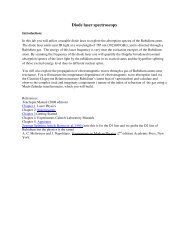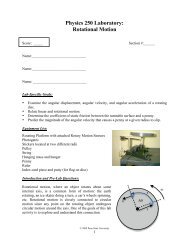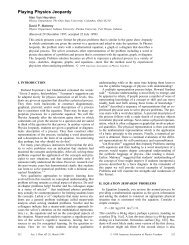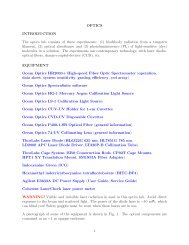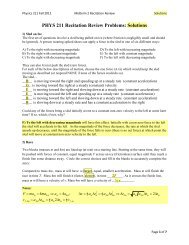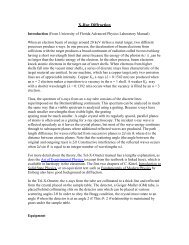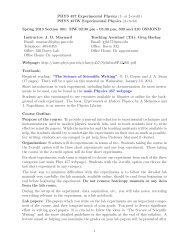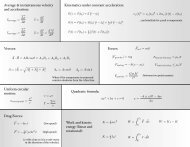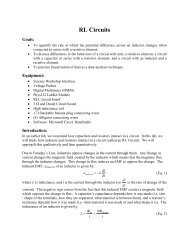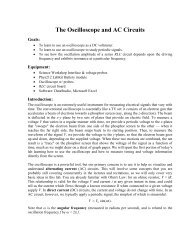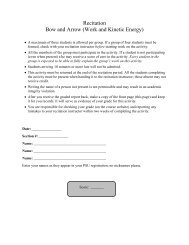Static Electricity (Lab 01)
Static Electricity (Lab 01)
Static Electricity (Lab 01)
You also want an ePaper? Increase the reach of your titles
YUMPU automatically turns print PDFs into web optimized ePapers that Google loves.
Through a very careful set of experiments involving a torsion balance and equally charged pith<br />
balls, the French engineer Charles Coulomb (1736–1806) was able to quantify the electric<br />
attraction and repulsion in the form we now call “Coulomb’s Law”. Coulomb’s law describes the<br />
force between two charged particles, labeled 1 and 2, and can be stated:<br />
1. If two point particles, having charges q 1 and q 2 respectively, are a distance r apart, the<br />
charges exert forces on each other with a magnitude of:<br />
q1<br />
q2<br />
F<br />
F<br />
<br />
k<br />
(Eq. 1)<br />
1on 2<br />
2 on 1<br />
2<br />
r<br />
These forces are equal in magnitude, but opposite in direction<br />
2. The forces are directed along the straight line drawn between the two charges. The forces<br />
are mutually attractive if the charges are opposite, and mutually repulsive for like<br />
charges.<br />
We will not repeat Coulomb’s experiment exactly, but we can make some qualitative<br />
observations using everyday items such as sticky tape, plastic pens, and metal keys, as well as<br />
some quantitative measurements with pith balls. With equipment as simple as this, we can repeat<br />
the same types of experiments that natural philosophers, inventors, and scientists have been<br />
performing for over 2400 years.<br />
Today, the process of rubbing two materials together to transfer some amount of electric charge<br />
is known as tribolectric charging. Table 1 below indicates the relative ability of a material to<br />
gain or lose charges due to rubbing. More plusses (+) next to a material in the chart indicates a<br />
greater ability to obtain a net positive charge. More minuses (−) next to a material in the chart<br />
indicates a greater ability to obtain a net negative charge.<br />
In general when two objects listed in the chart are rubbed together, the material listed higher in<br />
the chart becomes positively charged and the material listed lower in the chart becomes<br />
negatively charged (e.g., when rabbit fur is rubbed on glass, the fur will be positively charged,<br />
the glass negatively). The greater the separation of the materials in the chart, the greater the<br />
magnitude of the charge transferred.<br />
Material Relative charging with rubbing<br />
rabbit fur + + + + + +<br />
glass + + + + +<br />
human hair + + + +<br />
nylon/wool + + +<br />
silk + +<br />
paper +<br />
cotton<br />
−<br />
wood<br />
− −<br />
amber<br />
− − −<br />
rubber<br />
− − − −<br />
PVC<br />
− − − − −<br />
Teflon<br />
− − − − − −<br />
Table 1 Tribolectric charging



